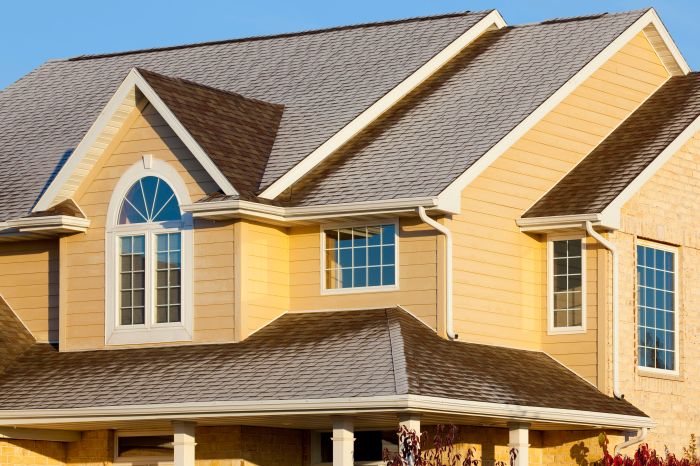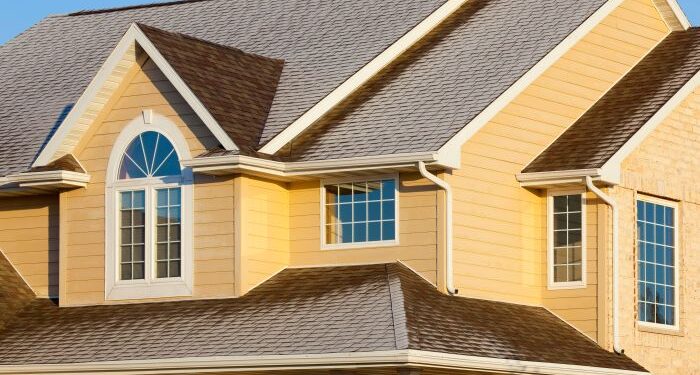Exploring the world of siding options for homes opens up a realm of possibilities. From classic materials to modern innovations, the quest for the best siding is an exciting journey filled with decisions and creativity. This guide delves into the nuances of siding choices, helping you navigate through the myriad of options to find the perfect fit for your home.
As we delve deeper into each aspect of siding materials, factors to consider, energy efficiency, aesthetics, and maintenance, you will gain valuable insights to make informed decisions for your home improvement project.
Types of Siding Materials
When it comes to siding materials for homes, there are several options to choose from, each with its own set of pros and cons. It's important to consider factors such as durability, maintenance requirements, and overall aesthetic appeal when selecting the right siding material for your home.
Vinyl Siding
Vinyl siding is a popular choice for homeowners due to its affordability and low maintenance requirements. It is available in a wide range of colors and styles, making it versatile for different home designs. However, vinyl siding may not be as durable as other materials and can crack or fade over time.
Fiber Cement Siding
Fiber cement siding is known for its durability and resistance to fire, insects, and rot. It can mimic the look of wood or masonry without the high maintenance requirements. However, fiber cement siding can be more expensive than other options and may require professional installation.
Wood Siding
Wood siding offers a classic and natural look to homes, adding warmth and charm. It can be painted or stained in various colors to match your style preferences. However, wood siding is prone to rot, pest infestations, and requires regular maintenance such as painting or staining to protect it from the elements.
Brick Siding
Brick siding is known for its longevity and timeless appeal. It is resistant to fire, insects, and harsh weather conditions, making it a durable choice for homes. However, brick siding can be costly to install and may require additional insulation for energy efficiency.
Metal Siding
Metal siding, such as aluminum or steel, is a durable and low-maintenance option for homes. It is resistant to fire, rot, and pests, making it a long-lasting choice. However, metal siding can dent easily and may require repainting over time to maintain its appearance.
Factors to Consider
When choosing siding for homes, there are several important factors to consider that can greatly impact the overall look, durability, and cost of the project.Climate plays a significant role in determining the best siding material for a home. Different materials have varying levels of resistance to extreme temperatures, moisture, and other weather conditions.
For example, vinyl siding is a popular choice in areas with mild climates, while fiber cement siding may be more suitable for regions with high humidity or frequent storms.The architectural style of a home can also influence the choice of siding.
Traditional houses may benefit from classic options like wood or brick siding, while modern homes often look best with sleek materials like metal or stucco. It's important to consider how the siding will complement the overall design aesthetic of the house.Cost implications are another crucial factor to consider when selecting siding materials.
Some options, like vinyl or aluminum siding, tend to be more affordable upfront but may require more maintenance over time. On the other hand, premium materials like cedar or stone siding can be more expensive initially but offer greater durability and longevity.
Climate Considerations
- Choose materials with high resistance to extreme temperatures and moisture in areas with harsh weather conditions.
- Consider insulated siding options to improve energy efficiency in regions with hot summers or cold winters.
- Consult with local contractors or experts to determine the best siding material for your specific climate.
Architectural Influence
- Match the siding material to the style of the home, whether it's traditional, contemporary, or rustic.
- Consider mixing different types of siding for a unique and visually appealing look that complements the architectural design.
- Take into account the color and texture of the siding to ensure it enhances the overall curb appeal of the house.
Cost Considerations
- Compare the initial cost, maintenance requirements, and longevity of different siding materials to determine the most cost-effective option.
- Factor in installation costs and any additional expenses, such as painting or repairs, when calculating the overall budget for the project.
- Consider the long-term savings of durable siding materials that may require less maintenance and replacement over time.
Energy Efficiency
When it comes to the energy efficiency of a home, the choice of siding material plays a crucial role. Different siding materials have varying levels of insulation properties, which can impact the overall energy consumption of a house.
Impact of Siding Materials on Energy Efficiency
The type of siding material used can greatly affect the energy efficiency of a home. For example, insulated vinyl siding provides better insulation compared to traditional vinyl siding, reducing heat loss in the winter and heat gain in the summer.
On the other hand, materials like wood or aluminum siding may not offer as much insulation, leading to higher energy bills due to increased heating and cooling needs.
Role of Insulation in Siding
Insulation in siding helps regulate the temperature inside a home by preventing heat transfer through the walls. This can lead to significant energy savings by reducing the reliance on heating and cooling systems. For instance, fiber cement siding with added insulation can improve the overall energy efficiency of a home by creating a thermal barrier that keeps the interior comfortable regardless of the external temperature.
Eco-Friendly Siding Options for Energy Efficiency
- 1. Insulated Vinyl Siding:Enhances energy efficiency by reducing heat transfer and improving insulation properties.
- 2. Fiber Cement Siding:Offers eco-friendly options with added insulation for better energy savings.
- 3. Engineered Wood Siding:Provides a sustainable choice with insulation options for improved energy efficiency.
- 4. Metal Siding:Can be eco-friendly and energy-efficient when combined with proper insulation materials.
- 5. Composite Siding:Offers a blend of recycled materials and insulation for a greener and more energy-efficient siding option.
Aesthetics and Curb Appeal
Siding plays a crucial role in enhancing the visual appeal of a home. It not only protects the exterior but also contributes significantly to the overall aesthetics of the property.When selecting siding colors and textures, it's essential to consider the architectural style of the home.
For traditional homes, neutral colors like beige or grey are safe choices, while vibrant colors can add a modern touch to contemporary designs. Textures such as wood grain or smooth finishes can also impact the visual appeal, so choose wisely to complement the existing elements of the house.Proper installation is key to achieving an aesthetically pleasing result.
Even the most beautiful siding can look unattractive if not installed correctly. Hiring experienced professionals for the installation ensures that the siding aligns perfectly, creating a seamless and polished look that enhances the curb appeal of the home.
Importance of Color Selection
When selecting siding colors, consider the neighborhood's overall color scheme. Opting for a color that complements the surrounding homes can help your property blend in or stand out in a tasteful manner. Additionally, dark colors can make a home appear smaller, while lighter shades can give the illusion of more space.
Textures and Architectural Styles
Different textures can evoke various architectural styles. For example, a smooth finish is ideal for modern homes, while a cedar shake texture can add a rustic charm to a cottage-style property. Matching the texture to the architectural style enhances the overall look and feel of the home.
Professional Installation
Proper installation is crucial for achieving a seamless and visually appealing finish. Hiring experienced professionals ensures that the siding is installed correctly, with attention to detail and precision. This not only enhances the curb appeal but also prolongs the lifespan of the siding.
Maintenance and Longevity

When it comes to choosing the right siding for your home, considering the maintenance requirements and longevity of the materials is crucial. Proper care and maintenance can significantly impact the lifespan of your siding, saving you time and money in the long run.
Maintenance Requirements for Different Siding Materials
- Vinyl siding: Vinyl siding is relatively low-maintenance, requiring occasional cleaning with a mild detergent and water to remove dirt and debris.
- Fiber cement siding: Fiber cement siding is durable but may require repainting every 5-10 years to maintain its appearance and protect against moisture.
- Wood siding: Wood siding needs regular painting or staining to prevent rot, mold, and insect damage. It also requires periodic inspections for signs of damage.
- Aluminum siding: Aluminum siding is easy to maintain and only needs occasional cleaning with a mild detergent and water to remove dirt and grime.
Lifespan of Various Siding Options and Factors Affecting Longevity
- Vinyl siding: 20-40 years, depending on quality and maintenance. Factors affecting longevity include exposure to harsh weather conditions and improper installation.
- Fiber cement siding: 30-50 years, with proper maintenance. Longevity can be affected by moisture exposure, improper installation, and lack of regular painting.
- Wood siding: 20-40 years, but can vary based on maintenance. Factors like moisture exposure, insect infestations, and lack of maintenance can reduce lifespan.
- Aluminum siding: 20-40 years, with proper care. Longevity can be affected by dents, scratches, and exposure to saltwater or harsh chemicals.
Tips for Prolonging the Life of Siding Through Proper Care and Maintenance
- Regularly inspect your siding for signs of damage, such as cracks, rot, or insect infestations.
- Clean your siding annually to remove dirt, mold, and mildew buildup using a soft brush or low-pressure washer.
- Trim trees and bushes near your home to prevent damage from branches rubbing against the siding.
- Repaint or restain your siding as needed to protect against moisture and UV damage.
- Address any issues promptly to prevent small problems from turning into costly repairs.
Final Review
In conclusion, the choice of siding for your home is not just a practical decision but also a creative expression of your personal style. By understanding the different elements that contribute to the best siding options, you are better equipped to transform your home into a masterpiece that stands the test of time.
Detailed FAQs
What factors should I consider when choosing siding for my home?
Consider the climate, architectural style of your home, cost implications, and maintenance requirements of different siding materials.
How does insulation play a role in siding for energy efficiency?
Proper insulation can significantly impact energy savings by regulating temperature within your home and reducing energy consumption.
What are some eco-friendly siding options that enhance energy efficiency?
Fiber cement, engineered wood, and insulated vinyl are eco-friendly options that provide excellent energy efficiency benefits.
How can I prolong the life of my siding?
Regular cleaning, timely repairs, and proper maintenance practices can help extend the lifespan of your siding materials.









